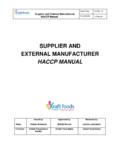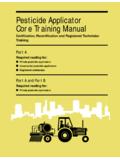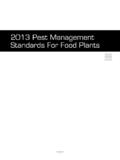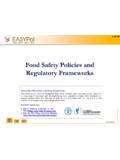Transcription of HACCP TRAINING MANUAL - FTP-UNU
1 PO Box 1390, Skulagata 4 120 Reykjavik, Iceland Final Project 2002 HACCP TRAINING MANUAL Maria Isabel Virg lio Omar Minist rio de Agricultura e Pescas Direc o Nacional de Pescas Rua Consiglieri Pedroso n 347 C. Maputo-Mo ambique Supervisors: Birna Gu bj rnsd ttir Icelandic Fisheries Laboratories and Sigurlinni Sigurlinnason, Accreditation Division. Omar TABLE OF CONTENTS TABLE OF 1 HACCP Benefits of the HACCP Some problems associated with the implementation of 2 GOOD MANUFACTURING PRACTICES Transportation and Equipment performance and 9 Sanitation and Pest Recall Consumer Complaint 3 HACCP Glossary of HACCP HACCP Principles and Assembly of HACCP Organization Chart and Description of the Identification of intended Construction of flow diagram and facility Identify hazards and preventive measures (Principle 1).
2 15 Identify Critical control Points (CCP) (Principle 2)..17 Establish Critical Limits (Principle 3)..17 Establish Critical control Points monitoring procedures (Principle 4)..18 Establish corrective actions (Principle 5)..18 Establish record-keeping procedures (Principle 6)..18 Establish verification procedures (Principle 7)..19 Validation or review of the HACCP List of APPENDIX 1:..23 Rules of Cause and Effect APPENDIX 2:..24 Critical control Point decision APPENDIX 3:..25 Example of HACCP plan of whole frozen 1. Organization Chart and Chart 2. Product 3. Process Flow 4. Whole frozen shrimp in-shell floor 5. Good Manufacturing 6. Regulatory Action and Quality 7. Hazard 8. Determination of Critical control 9. Records Keeping 10. Verification 11. APPENDIX 4:..46 HACCP UNU-Fisheries TRAINING Programme 2 Omar 1 INTRODUCTION The provision of safe food to the customer is a governmental and industry responsibility.
3 In order to ensure that food is safe it is good to establish a system to control food safety. In the past a positive approach was required using good manufacturing practices, hygienic production and product inspection. Today anyone exporting fish and fishery products, for most of the developed countries, will have not only to implement Hazard Analysis Critical control Point ( HACCP ) but also to meet international requirements for construction and hygiene. The demand for food safety is not limited only to exports, local consumers and regulators are increasingly demanding it. The fisheries industry in Mozambique, started in 1992 to implement quality management systems according to market demand. Considering that producers and workers have little knowledge of quality systems and there are no private consultancy firms in quality business, the government plays an important role in setting up and implementing quality management systems.
4 The purpose of this MANUAL is to design guidelines which will be used to promote a common approach for the identification of hazards, critical control points (CCPs) and critical limits; to promote understanding and awareness of food safety practices through education and to identity of develop the skills necessary to allow both the governmental (public) and private sectors to appropriately use HACCP and GMP to promote food safety. HACCP Background Hazard Analysis Critical control Point ( HACCP ) has become synonymous with food safety. It is recognized worldwide as a systematic and preventative approach that addresses biological, chemical and physical hazards through anticipation and prevention, rather than by finished production inspection. The HACCP concept was pioneered in the 1960s by the Pillsbury Company, the US Army and NASA as a collaborative development of the production of safe foods for the space program.
5 NASA wanted a zero defects program to guarantee safety in food that astronauts would be consuming in space. Pillsbury therefore introduced and adopted HACCP as a system that could provide the greatest safety while reducing dependence on finished product sampling and testing. Pillsbury presented the HACCP concept publicly at a conference for food protection in 1971. Especially during the last decade HACCP has become widely used and it is now a legislative requirement in some countries, for instance USA, Canada and EU-countries. There is no official HACCP standard but the system described by Joint FAO/ WHO, Codex Alimentarius Commission (1993) and adopted in 1997 is internationally recognized. UNU-Fisheries TRAINING Programme 3 Omar Benefits of the HACCP approach HACCP has a number of benefits for consumer, industry and government, that may be realized by applying the HACCP system as a management tool for food safety control of food processing and manufacturing.
6 The HACCP system is scientifically based and systematically identifies conceivable hazards and measures for control to ensure food safety. It focus is on prevention rather than relying mainly on end product testing. It is cost-effective and leads to reduced product loss and wastage. It increases the effectiveness of the quality system by focusing on the critical parts of the process. In addition it can aid inspection by regulatory authorities and promote international trade by increasing confidence in food safety and promote the stability of the food business. It complements and strengthens other quality management systems. Some problems associated with the implementation of HACCP Some companies, especially small and medium size, may be faced with problems in applying HACCP . For example, there may be insufficient technical resources to perform the HACCP study or difficulties with assembling the HACCP team because one or two people have many responsibilities concentrated in they hands.
7 The concentration of functions carries another problem. It is difficult for employees of this kind of company to include HACCP work in the daily routine and put aside the necessary time. The cost of implementation of the HACCP system relative to a company s turnover is higher than in larger companies; their small purchasing power cannot often exert sufficient influence on their suppliers to start using the HACCP system and the power that they can exert over clients is limited. This makes it difficult to ensure that the control of hazards is maintained right up to the point of sale. UNU-Fisheries TRAINING Programme 4 Omar 2 GOOD MANUFACTURING PRACTICES GUIDELINES HACCP is only one part of a larger system of control procedures . It is based on Good Manufacturing Practices. Good Manufacturing Practices or pre-requisite programs are programs that comprise the basic universal steps and procedures that control entire operating conditions within establishments and ensure favourable conditions for producing safe food.
8 GMPs include the following programs: Premises - Outside Property, Building, Sanitary facilities, Water/Steam/Ice Quality Program Transportation and Storage - Food Carriers, Temperature control , Storage of Incoming Materials, Non-food Chemicals, Finished product Equipment - Design, Installation, Maintenance and Calibration Personnel TRAINING , Hygiene and Health Requirements Sanitation and Pest control - Sanitation and Pest control Program Recall Program UNU-Fisheries TRAINING Programme 5 Omar Premises The premises include all elements in the building and building surroundings: the outside property, roadways, building design and construction, product flow, sanitary facilities, and water/steam/ice quality. They should be designed, constructed and maintained in a manner to prevent conditions that may result in the contamination of food Outside propertyAll outside areas of the plant should be free of debris and refuse that might be a source of insects and/or rodent infestation or cause objectionable odours, smoke, dust or other contaminants.
9 Roadways, yards and parking lots, should be properly graded, paved and maintained. They should provide and permit good drainage. Building Facilities should be designed, constructed and maintained in good repair to permit easy cleaning, prevent entrance and harbouring of pest and entrance of environmental contaminants. Floors, walls and ceilings should be constructed of approved materials that are durable, smooth, and cleanable. Walls should be light coloured, and floors sufficiently sloped for liquids to drain to properly trapped outlets. Windows should be properly screened if opened and doors should have smooth, non-absorbent surfaces and be close fitting. Stairs, elevators, overhead structures and other structures should be well designed and constructed so that there is no contamination of food and packaging materials. Adequate lighting should be provided throughout the facility, so that proper operation can be carried out.
10 Light bulbs and fixtures suspended over exposed food or packaging materials at any stage of production should be of a safety type or protected to prevent contamination of food or packing materials due to breakage. Adequate ventilation should be provided to prevent steam, condensation, dust and heat build-up and to remove contaminated air. Drainage and water disposal systems and facilities for waste storage should be designed and constructed so that the risk of contaminating food or potable water supply is avoided. They should be equipped with appropriate traps and vents. The traffic patterns of employees and equipment, materials and product should be such that the possibility of cross contamination between raw and processed food is eliminated. UNU-Fisheries TRAINING Programme 6 Omar Sanitary facilities Washrooms, lunchrooms and change rooms should be separate from and not lead directly into food processing areas and should be properly ventilated and maintained.







